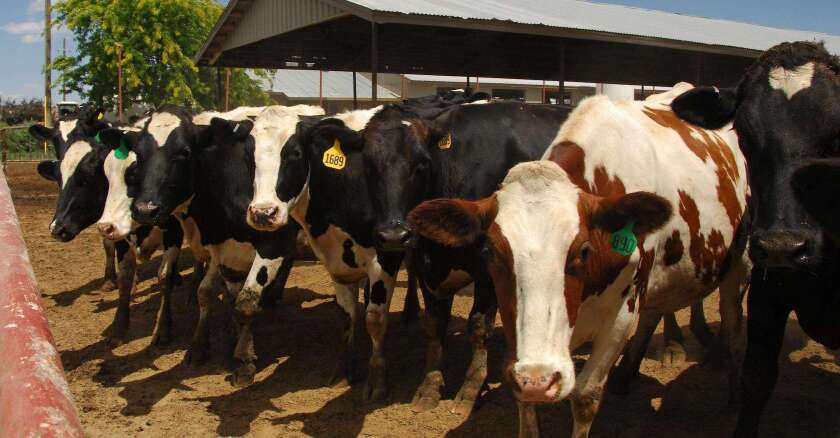“If we really don't want this to come into people, we need to do something about the cows,” says Seema Lakdawala, an immunologist at the Emory University School of Medicine. And she’s right.
Every time the virus reaches new host — bovine or human — it makes billions of new copies of itself and increases its odds of hitting on the combination of mutations it needs to start the next human pandemic.
Ever since the virus known as H5N1 was identified in dairy cows in March, it’s continued to spread around the country, turning up in 200 herds over at least 14 states. In Texas, a study of wastewater in September found the virus in 10 out of 10 samples. Scientists can’t be sure whether those signals are coming from animals or from people.
So far, only 14 people in the U.S. have tested positive for H5N1, but there’s very little testing taking place. A hospitalized patient in Missouri tested positive in September despite no known contact with birds or cows. A household contact of that person also tested positive. Two health care workers who were in contact with the hospitalized person reported flulike symptoms. (The workers recovered before they could be tested.)
H5N1 has been killing domestic chickens and wild birds and threatening people since the 1990s. The current outbreak dates to late 2022 or early 2023, when it started killing mammal species around the world, including seals, sea lions, grizzly bears, foxes, cats, mice and mink.
In previous human outbreaks, H5N1 had a staggering 50 percent fatality rate. This latest variant appears to be milder, but as we saw with COVID, even a disease that’s less than 1 percent fatal can be devastating if it circulates widely.
Big gaps remain in scientists’ knowledge. They still don’t know if infected cows become immune or can get re-infected. They don’t know if some infections might be asymptomatic. They don’t know how long diseased cows can spread the virus.
We urgently need answers to those questions. That starts with a more aggressive posture from the U.S. Department of Agriculture, the Centers for Disease Control and Prevention, and state public health departments.
Most of the surveillance is currently being done through testing of pooled milk, said Lakdawala. While some infected cows show symptoms, others might be spreading the disease silently. Farmers whose pooled milk tests positive need the tools to follow up by testing each individual cow, enabling them to isolate the infected ones and stop further spread.
Lakdawala said dairy farms often use machines to milk cows and these aren’t always sanitized. Research that her group has done showed that the virus persists for long periods of time on milking equipment. She says contaminated equipment is likely one of the primary routes of spread among cows.
She’s also worried about the contaminated milk that farmers have been sending down the drain. “We have reports that these cows can have as much as 100 million infectious virus particles in one little milliliter of milk,” she said. And dairy farmers are pouring away gallons. The infectious milk goes to manure lagoons, she said, where solids are separated out and liquids can go into irrigation fields. In some cases, they’re finding dead cats on these fields. (Cats are known to be susceptible to H5N1).
It’s possible to kill the virus by treating the milk with high heat, but farmers don’t always have the means to do that, she said, so her lab is working on less expensive ways to sanitize infectious milk before it’s discarded.
And cows are still being moved across the U.S., sometimes without sufficient testing, she says. “We need to have a temporary ‘stay at farm’ order where cattle are just not moved while we figure out which cattle are infected,” she said.
More testing in humans would also help monitor the situation, said epidemiologist Jennifer Nuzzo, director of the pandemic center at Brown University. “We’re not getting ahead of the problem.”
“The fact that farm workers continue to be infected in the course of their jobs means that this is a serious public health situation,” she said. “I don't think we should wait for a farm worker to die before we get concerned about protecting them.”
The risk of a more dangerous variant emerging will rise with the start of the fall flu season. Different influenza viruses can infect the same person and exchange genetic material. Something new could emerge with the ability to spread easily from human to human — “our worst-case scenario,” she said.
If this virus were spreading in dairy farms in China rather than the U.S., she said, we’d be demanding more testing, more transparency about the extent of the disease, and the details of those mysterious cases in Missouri. “I've gotten assurances from CDC and local health that they've done contact tracing [but] there's no data about it,” Nuzzo said. If we want other countries to be transparent with us, “we need to be transparent.”
Right now, scientists can’t put a number on the odds this virus will cause the next pandemic. But the risk goes up the longer the virus circulates in domestic animals. It’s time to lock down the cows.
©2024 Bloomberg L.P. Distributed by Tribune Content Agency, LLC. F.D. Flam is a Bloomberg Opinion columnist covering science. She is host of the “Follow the Science” podcast.
This column does not necessarily reflect the opinion of the Bloomberg L.P. editorial board or Bloomberg LP and its owners. Governing's opinion columns reflect the views of their authors and not necessarily those of Governing's editors or management.
Related Articles












